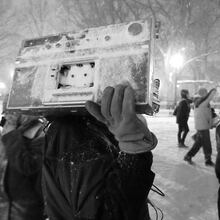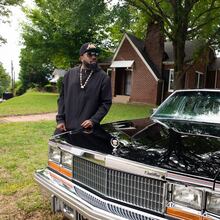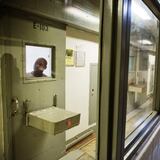A young Eric Boe, not even 5 years old, was awestruck while watching grainy images of two American astronauts in bulky spacesuits bounce around on another celestial body.
The footage was blurry. But no matter — it was captivating for Boe and millions of others gathering around their black-and-white televisions on July 20, 1969.
As Boe saw the moon landing from his living room in Atlanta, he felt an indelible connection to the historic moment.
Here were Neil Armstrong and Edwin "Buzz" Aldrin walking on the moon — the same moon Boe looked at from his bedroom window at night, the same moon he saw shining in the dark sky during evening walks with his family in the Northlake neighborhood of DeKalb County.
“It was a real dreamy moment,” said Boe. “It’s amazing to look at something in the sky that seems so far away but be so close we could reach out and touch it.”
As the years went by in school, college and the Air Force, Boe’s affinity for and connection to space strengthened. And then, in 2000, Boe was selected by NASA to be an astronaut. Since then, he has piloted two space shuttles. And now, Boe, 54, is one of the astronauts chosen to fly on commercial spacecraft and be among the first American astronauts to launch from U.S. soil since 2011.
The voyages are scheduled to begin next year, and Boe, who has been tapped to fly on Boeing's Starliner, is part of an elite group of astronauts NASA hopes will usher in a new era of space travel.
While Boe is stationed in Houston, he continues to maintain strong ties to Atlanta and have a soft spot for his hometown. Atlanta is also the place where family, friends and teachers helped his galactic dreams come true.
A determined student
When Boe was about 12 years old, he enrolled in a Discovery aerospace class at the Fernbank Science Center. It was a perfect class for a bright child who loved math and science. He made rocket models, studied aerospace history, went on field trips to Dobbins Air Force Base in Marietta. He loved all of it — everything from looking through telescopes to building rockets and flying rockets from Piedmont Park.
And Boe credits his teacher, Debi Huffman, for helping nurture his enthusiasm for aerospace.
“Absolutely one of the things I talk about when I talk to students is how impressed I am by teachers who spend a lot of time with kids and are very dedicated,” said Boe.
During class, Boe told Huffman his dream of one day becoming an astronaut. He promised to have her as his guest at his first space mission.
Meanwhile, Huffman, who still works at the Fernbank Science Center, remembers Boe as a hardworking and passionate learner. He also paid careful attention to details, even as a middle-schooler.
In class, students built rockets out of kits, and needed to attach fins, which provided stability during a flight, Huffman said. Sometimes, the fins fell off, and students needed to reattach them. But not Boe.
“Boe always did it perfectly the first time,” she said.
Huffman said Boe’s determination as a young student paid off.
“Everything he did as a student was something that got him closer to his dream,” Huffman said. “He’s a fabulous role model for students I teach because I can tie in his footsteps and use those to encourage kids.”
Boe was also influenced by his parents. His father was a pilot in the Air Force and flew for Eastern Airlines. And his mother often took him to the library to research projects, not only libraries close to home but also university libraries including the one at Georgia Tech.
From Iraq to NASA
In high school, Boe continued to excel in school and loved learning. His favorite subjects included science, Spanish and math classes — especially calculus.
“It’s something concrete that I could put my hands around, and there was an answer,” he said.
Boe became a cadet in the Georgia Wing of the Civil Air Patrol, earning the coveted Gen. Carl A. Spaatz Award. Boe graduated from Henderson High School (which is now a middle school) in DeKalb County in 1983. (Another astronaut, Thomas Henry "Tom" Marshburn, graduated from Henderson High School in 1978.)
Then, Boe entered the Air Force Academy to study astronautical engineering. After graduating from the Air Force Academy, he became a test pilot. He also flew 55 combat missions over Iraq in support of Operation Southern Watch. Before his military retirement in 2012, he logged approximately 6,000 flight hours in more than 50 aircraft.
Boe, who is married and has two children, said he always wanted to be a pilot, and “in the back of my mind, I thought about being an astronaut.” But he also knew the odds — with tens of thousands of applicants seeking only a handful of coveted spots.
“I knew becoming an astronaut would take a lot of luck and being at the right place at the right time, so my first goal was being a pilot, and a test pilot, because I knew by doing that, you could open up some of those gates,” said Boe, an upbeat, unassuming man.
Boe received his master's degree in electrical engineering from Georgia Tech in 1997.
In 2000, Boe’s lifelong journey of maybe — just maybe — becoming an astronaut came to fruition. He was 35 years old.
Credit: Photo: NASA
Credit: Photo: NASA
Previous trips to space station
Huffman stood by with white knuckles at Cape Canaveral, Fla., as the space shuttle Endeavour cut its way into the evening sky on Nov. 14, 2008.
Huffman’s presence was a promise made good by Boe. Boe packed a special Fernbank flag on his first shuttle mission, a testament to what the science center has meant to him and his career as an astronaut.
Boe piloted the STS-126 Endeavour, a mission that expanded the living quarters of the International Space Station to eventually house six crew members by delivering a new bathroom, kitchen, two sleeping quarters, an exercise machine, and a water recycling system. He also served as the pilot for STS-133 Discovery. This mission delivered the Permanent Multipurpose Module (PMM) and the fourth Express Logistics Carrier (ELC) to the International Space Station, a research laboratory that orbits around Earth.
The space station is a unique science laboratory for human health, biological and materials research as well as a technology test bed. The space station is also considered a steppingstone for going farther into the solar system.
It has the volume of a five-bedroom house or two Boeing 747 jetliners. It can support a crew of six people, plus visitors.
Along with the sensation of weightlessness, it’s the view of his homeland from space that really made an impact on Boe.
MORE: NASA discovers perfectly formed, rectangular ice sheet
“No words can describe how amazing our planet is,” he said. “You can tell the planet is alive. You can see the colors — the greens and blues. It’s big and small at the same time.”
When construction of the International Space Station was begun in 1998, it was seen as a new age of cooperative space exploration — an alliance between a number of countries, but especially longtime rivals the United States and Russia.
And since the retirement of NASA’s space shuttle fleet in 2011, U.S. astronauts have relied entirely on Russian rockets and capsules to reach and return from the space station.
While the tenor of Russian-American relations has changed, in space, the two countries remain close.
“We train together; we work together,” Boe said. “You get to know the crew very well when you work with them day in and day out for years.”
Boe studied Russian at the Air Force Academy, which has been quite useful — although not the way he initially envisioned.
“I studied Russian because it was during the Cold War, and I wanted to know my enemy,” said Boe. “I am still learning Russian, but we are working together, and I am using Russian in a constructive way to make the world a better place.”
In that same vein, he said something else you don’t see from space are borders.
“You don’t have those conventional lines, and you realize we are all in this life together — planet Earth and humanity as a whole,” Boe said.
Ultimately, he said, you see the complexity of Earth and it “kind of gives you an appreciation for life in general.”
Boe said Georgia state is on his short list of places to photograph from the sky, along with Mount Everest and New Zealand. On Nov. 20, 2008, he flew over Bobby Dodd Stadium when Georgia Tech was playing a football game.
MORE: NASA: Evidence of flowing water on Mars
Credit: Jason Getz
Credit: Jason Getz
After returning to Earth on Endeavour, Boe returned the flag to Fernbank in a special ceremony.
Boe, who spent a total of nearly 29 days in space, said as he reflects on his time traveling in space, he’s come to realize the time in orbit is just a small part of an astronaut’s journey.
“Space flight is about people. For me, a lot of the fun is training and getting to know people and working together. There are 500 to 1,000 people supporting us, training us, meeting, making our equipment. There are a lot of people who make our job easy.”
And when he’s in space, he said, “You are very busy. But every once in a while, you take a breath,” and marvel at the experience — and view from space.
“I tell young people that there are a lot of cool jobs,” he said. “And being an astronaut is a cool job. But there are a lot of great things to do. The important thing is to find something you love to do, and you’ll do it well. Life is an amazing thing.”
‘Next chapter in space travel’
In a ceremony at the Johnson Space Center in early August, NASA Administrator Jim Bridenstine stood on a stage with an enormous American flag, and introduced the selected astronauts, one by one, for the next phase in space travel. He started with Boe, who greeted an enthusiastic crowd with a wave and two thumbs up.
“What an exciting and amazing day,” said Bridenstine.
“I am honored and consider myself very lucky to have this opportunity to see this next chapter in space travel,” said Boe.
The plan is for Boe and other selected astronauts to fly on spacecraft developed not by NASA but by two corporations, which are under contract to develop “space taxis” to the International Space Station. In 2014, Boeing and SpaceX were awarded a combined $6.8 billion in contracts from NASA to develop, test and fly space taxis to carry U.S. astronauts into orbit.
All of the selected astronauts are in their 40s and 50s.
Boe is currently training for the crew flight test of Boeing's Starliner spacecraft. As they work to help launch a new phase for conducting space research, both Boeing and SpaceX have faced setbacks and delays, but test flights are scheduled for sometime next year. Not only will it be the end of a period when American astronauts have had to essentially hitch rides aboard Russian spacecraft, but this also will mark a new phase of travel on newly developed sleek aircraft. Everything from heat shields, abort systems, and parachutes to seats, controls and displays have been developed by teams at each company.
And for those who played a role — big and small — in Boe’s space travels, this is a moment of great joy.
“I was just sick when they ended the program,” said Jean Thomas, a retired teacher who taught Boe in elementary school. “I am so thrilled to get things back going again. And we are so proud of Eric.”
Meanwhile, Huffman, who has helped countless students — including one future astronaut — follow their passions to become scientists, engineers, doctors and inventors, plans to retire at the end of this school year.
But next time Boe launches into space, Huffman plans to be there — once again cheering on the man she remembers as a 12-year-old boy with tenacious dreams of soaring past the stars.
And this next step in exploration could take astronauts, including Boe, back to the moon, eventually Mars — and beyond.
— Jon Waterhouse contributed to this article.
About the Author












